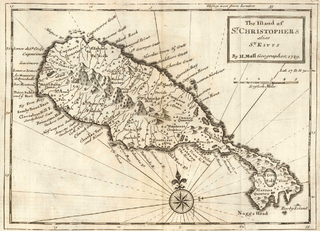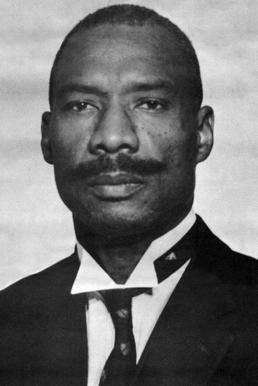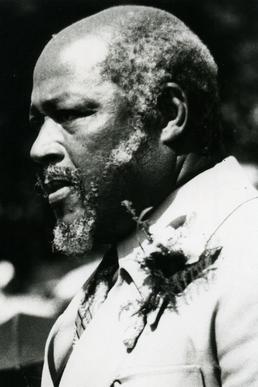 |
|---|
| Administrative divisions (parishes) |
General elections were held in Saint Kitts-Nevis-Anguilla on 6 October 1952, [1] the country's first elections held under universal suffrage. [2] The Workers' League won seven of the eight elected seats.
 |
|---|
| Administrative divisions (parishes) |
General elections were held in Saint Kitts-Nevis-Anguilla on 6 October 1952, [1] the country's first elections held under universal suffrage. [2] The Workers' League won seven of the eight elected seats.
The previous elections had taken place in 1946, and the next elections were due in 1949. However, they were postponed each year until 1952. [3]
A new constitution introduced in 1952 provided for a 14-member Legislative Council, consisting of eight elected members, the Governor (as President of the Council), two ex officio members and three appointed members. [4]
| Party | Votes | % | Seats | +/– | |
|---|---|---|---|---|---|
| Workers' League | 10,528 | 80.95 | 7 | +2 | |
| Saint Kitts Democratic Party | 482 | 3.71 | 0 | New | |
| Independents | 1,996 | 15.35 | 1 | 0 | |
| Non-elected members | 6 | – | |||
| Total | 13,006 | 100.00 | 14 | – | |
| Valid votes | 13,006 | 98.03 | |||
| Invalid/blank votes | 261 | 1.97 | |||
| Total votes | 13,267 | 100.00 | |||
| Source: Nohlen, Midgett [5] | |||||

Saint Kitts and Nevis, officially the Federation of Saint Christopher and Nevis, is an island country consisting of the two islands of Saint Kitts and Nevis, both located in the West Indies, in the Leeward Islands chain of the Lesser Antilles. With 261 square kilometres (101 sq mi) of territory, and roughly 48,000 inhabitants, it is the smallest sovereign state in the Western Hemisphere, in both area and population, as well as the world's smallest sovereign federation. The country is a Commonwealth realm, with Charles III as king and head of state.

Saint Kitts and Nevis have one of the longest written histories in the Caribbean, both islands being among Spain's and England's first colonies in the archipelago. Despite being only two miles apart and quite diminutive in size, Saint Kitts and Nevis were widely recognized as being separate entities with distinct identities until they were forcibly united in the late 19th century.

Robert Llewellyn Bradshaw was the first Premier of Saint Kitts and Nevis, and previously served as Chief Minister, legislator, and labour activist.

Caleb Azariah Paul Southwell was the second Premier and first Chief Minister of Saint Kitts and Nevis in the Caribbean. He also worked as a teacher, police officer, and trade unionist.

Saint Christopher-Nevis-Anguilla was a British colony in the West Indies from 1882 to 1983, consisting of the islands of Anguilla, Nevis, and Saint Christopher. From 1882 to 1951, and again from 1980, the colony was known simply as Saint Christopher and Nevis. Saint Christopher and Nevis gained independence in 1983 as the Federation of Saint Kitts and Nevis, while Anguilla would remain a British overseas territory.

The People's Action Movement (PAM) is a political party in the island nation of Saint Kitts and Nevis. The party currently holds one of the 11 seats in the National Assembly. PAM operates only in Saint Kitts and for the 2022 general election is in a 'One Movement' alliance with the Concerned Citizens' Movement (CCM) operating in Nevis, following the breakdown of the governing Team Unity alliance. PAM is a member of the Caribbean Democrat Union, the regional affiliate of the International Democrat Union and shares close links with other centre-right party members in the Caribbean such as the Jamaica Labour Party.
The Saint Kitts and Nevis Labour Party (SKNLP), also known simply as Labour, is a centre-left political party in Saint Kitts and Nevis. It is currently in government in the country after winning six of the eleven contested seats in the 2022 general election. It is the oldest active political party in the English-speaking Caribbean.

The National Assembly and the King of Saint Christopher and Nevis jointly make up the legislature of Saint Kitts and Nevis.

West Indies Associated States was the collective name for a number of islands in the Eastern Caribbean whose status changed from being British colonies to states in free association with the United Kingdom in 1967. These states were Antigua, Dominica, Grenada, Saint Christopher-Nevis-Anguilla, Saint Lucia, and Saint Vincent.

General elections were held in Saint Kitts-Nevis-Anguilla on 6 November 1957. The result was a victory for the Saint Kitts-Nevis-Anguilla Labour Party, which won five of the eight seats.

General elections were held in Saint Kitts-Nevis-Anguilla on 16 November 1961. The result was a victory for the Saint Kitts-Nevis-Anguilla Labour Party, which won seven of the ten elected seats.

General elections were held in Saint Kitts-Nevis-Anguilla on 25 July 1966. The result was a victory for the Saint Kitts-Nevis-Anguilla Labour Party, which won seven of the ten seats. Voter turnout was 70.2%.

General elections were held in Saint Kitts-Nevis-Anguilla on 10 May 1971. The result was a victory for the Saint Kitts-Nevis-Anguilla Labour Party (SKNALP), which won seven of the nine elected seats. The SKNALP won all seven seats at the island of Saint Kitts, while the two seats at the island of Nevis were divided between the People's Action Movement and the Nevis Reformation Party. Anguilla, which was nominally entitled to one seat, boycotted the elections in the aftermath of the 1969 referendum. Voter turnout was 87.9%.

General elections were held in Saint Kitts-Nevis-Anguilla on 1 December 1975. The result was a victory for the Saint Kitts-Nevis-Anguilla Labour Party, which won seven of the nine seats.

General elections were held in Saint Kitts-Nevis-Anguilla on 24 June 1937, the first since the 1870s. The Workers' League nominated two candidates, Thomas Manchester and Edgar Challenger, both of whom were elected.

General elections were held in Saint Kitts-Nevis-Anguilla on 16 September 1940. The Workers' League won all the elected seats.

General elections were held in Saint Kitts-Nevis-Anguilla on 20 September 1943. The Workers' League won all the elected seats, defeating an alliance of merchants and planters nominated by the Agricultural and Commercial Society.

General elections were held in Saint Kitts-Nevis-Anguilla on 30 July 1946. The Workers' League won all the elected seats, with no party running against them.

General elections were planned to be held in Anguilla on 25 October 1967 following the Anguillian Revolution in May. However, only five candidates stood for the five seats, with all elected unopposed.

General elections were held in Anguilla on 30 July 1968.